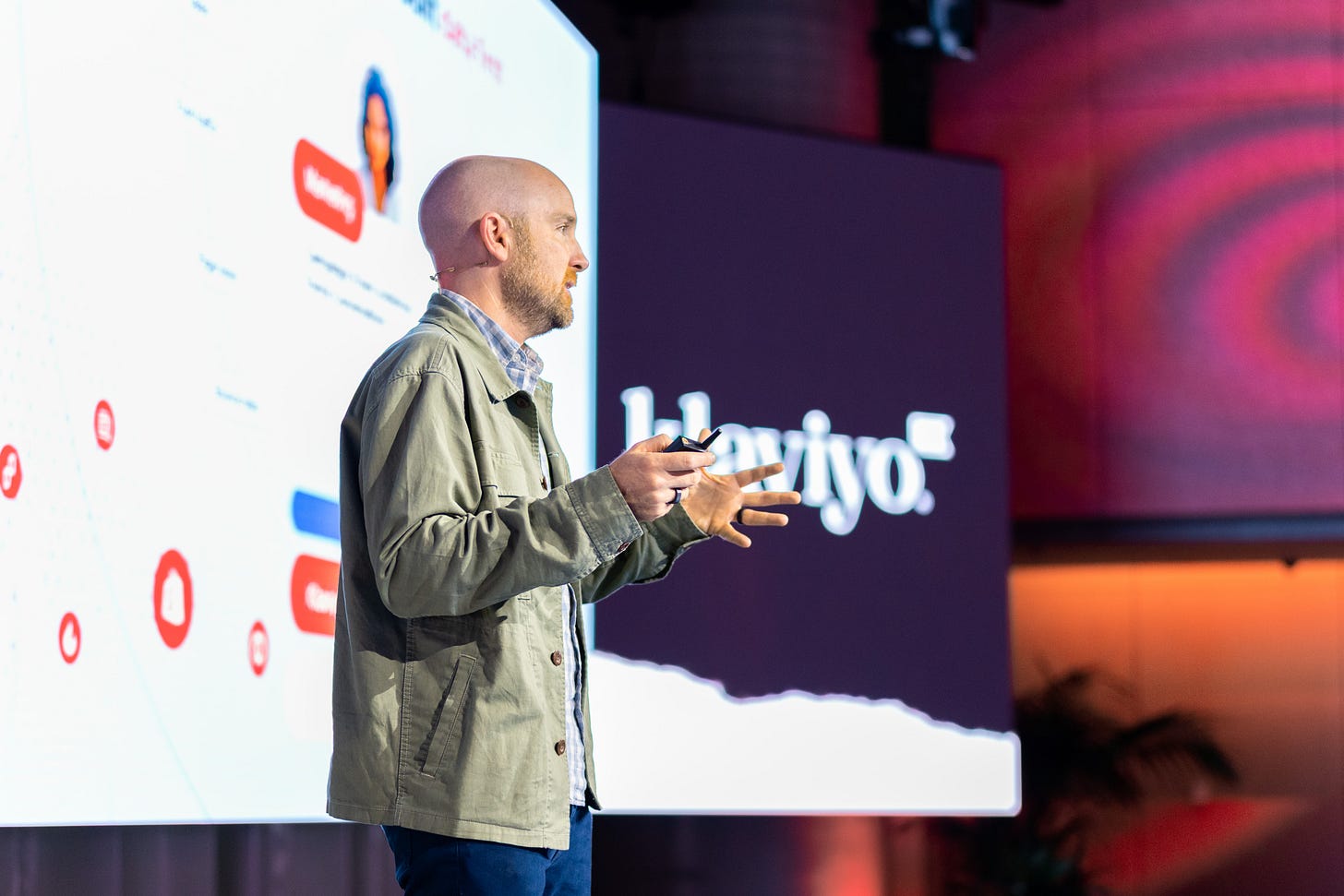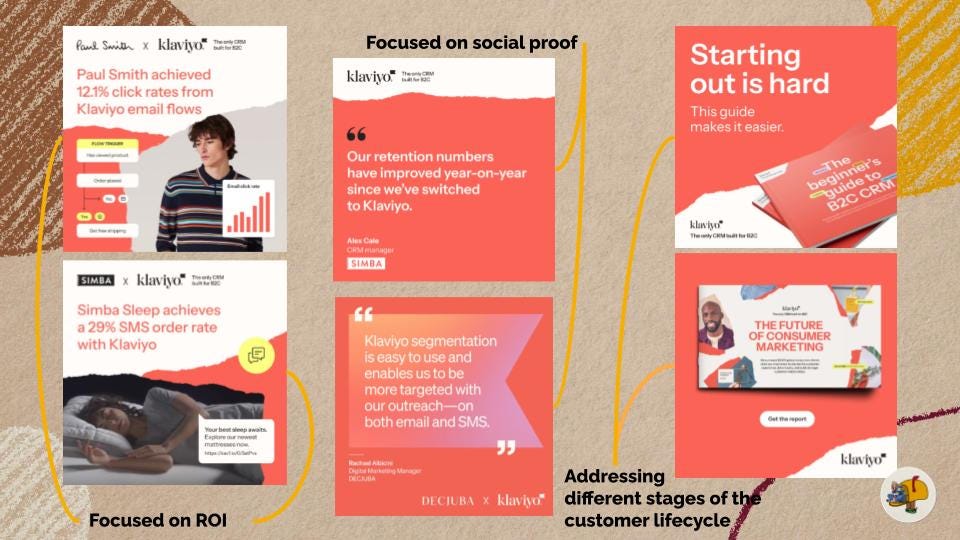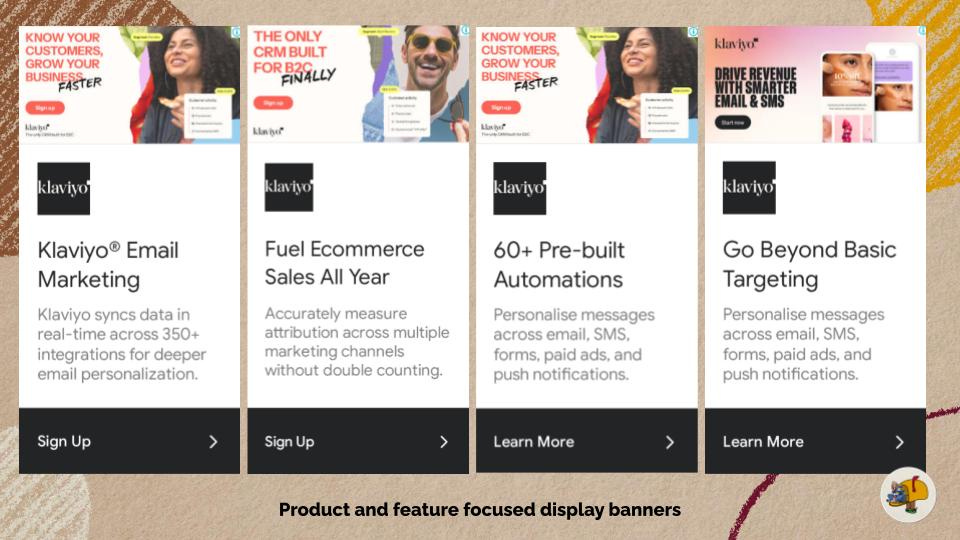Business growth: It's not that different between a local restaurant and a software company
Season 9, Issue 10: An interview with Kalviyo co-founder, Ed Hallen
📬 In this issue:
How does the definition and goals of “growth” change at different company sizes
The importance of looking to a similar stage company when benchmarking your marketing efforts
An exclusive interview with Ed Hallen, co-founder and Chief Strategy Officer of Klaviyo!
Hola Mehketeers,
I’m really interested in how the concept of “growth” changes from one stage of business to the next. Initially, growth is gaining the first paying customer. Then it’s hitting 10 customers, then 30 customers, validating you’ve got true product-market fit.
Once you’ve hit that, maybe your growth metric changes to how much revenue you’re making. Maybe it changes to which funding series you’ve hit, or how much you’ve raised. For public companies, growth is measured in stock prices and shareholder value.
This week, I had a chance to ask someone who’s truly been through it all about it. Klaviyo was bootstrapped, then VC funded, and IPO’d on the New York Stock Exchange (NYSE) in September of 2023.
I sat down with Ed Hallen at the Klaviyo K:SYD event and asked him all about it.
Not only is this the first Mehdeeka interview I’ve conducted in person(!!) it’s also the first in what I hope to become a series or even a dedicated season around growth tactics at different stages so Mehketeers can find a like-for-like cohort of companies to look to for inspiration (because trying to copy what Canva is doing when you’re in a marketing team of two is… not it, fam.)
Quick context about Klaviyo:
Klaviyo is a B2B SaaS platform for B2C businesses. They just launched the first “built for B2C” CRM, and their customer based is made up of ecommerce, retail, and other brick and mortar businesses.
“It always just comes back to the customers”
This interview has been lightly edited for clarity and conciseness. I didn’t get a picture of us together, but here’s Ed on stage:
K: How did you know when you had product-market fit?
E: When we started, we had this approach of find a problem, solve it, people pay us and then once you found the first ten of those people, go find the next 20 of those people and then after we found that first thirty, it's like, OK, how do we find a sustainable way to go find more.
It's not good enough for us just to hustle. It probably took us 18 months to have that set of 30 customers, but it was very clear — we were talking to all of them — it was very clear. They're happy.
There was like a real need because they were handing us money to solve the problem, and they word of mouth growth was happening really quickly. We didn't take the approach of ‘come up with an idea that investors will like and build slides.’
It was always like go solve a problem for customers. It wasn't clear how big it was going to be, but it was clear like, hey, there's a real business here that one day could at least like fully pay our salaries and let us build at least a small company. And then over time it was like, wow, there's actually a bunch of these people, this could be like big company.
K: How does how you view growth change as the company gets bigger?
E: I mean it's different. Different scales. So in the earliest days, it was just how do we get to 10 customers after a couple of years? It was very clear there was plenty of customers. But it was, ‘hey, how do we get to as many as we can as fast as we can?’
It's always been very important for us to run a business like we run our personal lives. Sure you could just spend tonnes of money and find customers and grow very fast.
But for us, it's always been [that] the customers pay you money. You can then use that money to run the business, and that includes finding new customers. But you're not massively going into debt or going out to venture capitalists. And so that's how we always thought about it. That model of, ‘hey, how do we grow profitably in the way we want to grow?‘ is still basically the same.
The percentages are just different because now we have to go into new markets and buy new types of customers. But it's really the same. It's the same thing.
K: Is there a difference between growth for a public company and growth for a privately held company?
E: I think there can be.
When we thought about going public, it was very important to us that we don't change any of the core values, what the company is about. and so. And I think we're very fortunate to do that.
And so it's still been about, ‘OK, this is about customers. We grow because we solve problems for them. How do we find as many as we can?’
It's not about shareholders or impressing the stock market. The stock will go up, the stock will go down. It's just about going out and helping more customers. We've kind of always held ourselves to a very high standard and we think about that mostly as “fulfilling our potential.”
If you have the opportunity and the potential to work hard and do amazing [things] for customers, why not do it? That was true when we were private. It's true when we’re public. It always just comes back to the customers.
K: Is there a difference in terms of how much freedom you have to take a big bet?
E: Not really. I think there can be. But in our case, you know, we were very fortunate.
It's still fundamentally a founder run company and it's still very customer focused and there's a discipline that comes with reporting your financial metrics and having and talking to all these market investors, but it's not, you know we still fundamentally run the company. It's still basically the same board that it was when we were private.
I think in in some ways it just further encourages us to be more ambitious. There are things that we could do that the public markets would hate, like waste a bunch of money, but we would also hate wasting a bunch of money.
It's very much aligned with making sure you know, long term, we'll take risks, people might not like what we'll do. That's all fine. And then we just kind of ignore whatever's happening in the stock market.
Kayla: What customer metrics do you track?
Ed: We've always thought about it, as you know, the same idea of business. You find a customer problem, you solve it with software, if it's a big enough problem, somebody will pay you. And so the reason somebody paying you matters is because it's a vote of like, ‘you're doing something real for me’.
And so we track new customers who are coming in the door, and understanding the different types of customers you have. There's the small ones, there's the really big ones, there's brands, there's people outside ecommerce. So we’re very focused on growth really as a proxy for doing something valuable for customers.
The second piece is then, OK, if you're like continually delivering value, people are very excited to remain customers and so you [track] churn. You [track] how many customers are sticking around and why?
And then the third, which is super unique to our business, you want to find some sort of proxy for customer value. And so we have this thing called Klaviyo attributed value where we can take all the data we have and measure the how much growth are we driving for [our customers]. The belief is, if we're driving growth for them then they're going to be very happy customers and we've now seen that play out with all sorts of NPS and other surveys.
So those are the three financial metrics and then the the fourth is just NPS. And so it's understanding how customers feel about us and why. And I think that the goal there is not just the NPS, but also all the context that goes into it, to understand, OK, people love this, people hate this. There're these specific people who have this problem. It’s a gold mine of, hey, where're the ways we can do things to get better?
K: Have the metrics you’ve focused on changed over the lifespan of Klaviyo?
E: I mean, kind of. In the early days we took an approach of, you know, talk to customers as much as possible and be as much into the details of how we can help them as we can. And so when we started having a sales process, we thought about it as one more touch point to work with customers to understand what they're trying to accomplish and then help lead them to those goals to actually accomplish them.
So in the early days, [we focused] so much more on the feedback rather than things like NPS. Literally we would have been talking to every customer as much as possible. We still talk to customers as much as possible. We can't talk to all 175,000 of them. And so we've gradually shifted from more of that qualitative, anecdotal feedback to NPS. But all the others [metrics are] basically the same.
There are lots of other things you can measure that are important, like what percentage of our customers are in the US, not in the US. But it all comes back to ‘are your customers happy?’
And I guess then there's the cost piece like do you sell it for a lot more than it costs you to make it. That's what a business is. It's not that different between a local restaurant and a software company, right?
K: What’s the next growth milestone for Klaviyo?
E: Yeah, [we have] this internal saying that we're 1% done. When we started, we were like the fun thing about having our company is — in addition to not having a boss — is you get to go out and all your time is spent solving real problems that exist in the world and that seemed like an incredible job to have, and it still feels like it.
If we like, rewind to 2012, when we started the company and you say, ‘hey, 13 years from now, you'll be in Sydney, you'll have thousands of employees, you'll be a public company,’ we would just been, like, totally dumbfounded.
But if, at the same time, you're like ‘oh, but, you're still mostly a marketing company, you're still mostly an ecommerce company,’ I think would be like, ‘it feels like we could do so much more, there's so many more things we could do to grow in all different areas.’
And so it's still really the same thing. Go out, find customer problems. More and more we're learning. It's not just marketing, it's every customer touch point that exists and I think it's ours to lose and we have to lean in and again figure out how we solve these problems for customers.
There’s no shortcut.
Join the Mehdeeka Substack chat and tell me if you want more of this!
I started using the Substack chat feature last week, and will be doing so over the coming weeks with threads for specific Mehdeeka issues. I’d love for you to join and tell me what you thought about this issue! Would you like more like this? Should I do the growth focused season or just periodic interviews?
You tell me. Literally, tell me.
Huge thanks to Ed for speaking to me so candidly and openly on an incredibly busy day, and Startup Daily for extending the invite for the interview. I wrapped up my time on the Startup 360 podcast last week, but you can catch all the episodes I was in on Youtube, and of course watch the new episodes with a new co-host!
Hope you enjoyed this one,
Kayla







Great questions! Who’s the next billionaire you’re interviewing 🤑